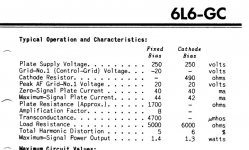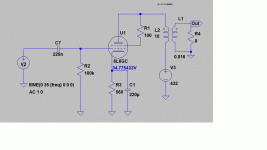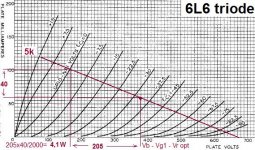I should know this but i'm running into brainlock. What's the power output (W) for a SE 6L6GC 432V on Plate, 33.4V on Cathode 58.8ma into a 5k output transformer.
Thanks,
Paul😕
Thanks,
Paul😕
In my case learning LT Spice created drawbacks too.
Nowadays I build far less prototypes than some years ago, but maybe better prototypes.
Nowadays I build far less prototypes than some years ago, but maybe better prototypes.
Real life testing under similar conditions in a Tubelab SSE amp gives 3.5 to 4.5 watts depending on the tube, the OPT, and how much distortion you will accept. All OPT's were 5K or 6K, some are just more lossy than others.
Triode Strapped
I think you'd get @2W or less according to the data sheet at your voltages.
This is for a guitar amplifier with a pair of 12ax7s feeding it. at some point i'll break out the freq generator and O-scope and try to measure actual output but in real world is would vary based on how hot the guitar signal is. At this point i'm running the tube at about 80% so reliability should not be an issue.
Thanks for all the input
Paul
Thanks for all the input
Paul
I think you'd get @2W or less according to the data sheet at your voltages.
What data sheet says so ?
RCA 1960What data sheet says so ?
A little interpolation against the chart will tell you you won't be able to swing for much more power than the typical setup. You'll fry the tube.
Attachments
LT Spice gives 1.2 W with those values (Cathode bias).
So far no conflict between simulations and data sheet. This means that the earlier simulated result 4 W is likely.
And did you noticed what Tubelab told ? Actual circuits have given 3.5 W to 4.5 W.
So far no conflict between simulations and data sheet. This means that the earlier simulated result 4 W is likely.
And did you noticed what Tubelab told ? Actual circuits have given 3.5 W to 4.5 W.
LT Spice gives 1.2 W with those values (Cathode bias).
So far no conflict between simulations and data sheet. This means that the earlier simulated result 4 W is likely.
And did you noticed what Tubelab told ? Actual circuits have given 3.5 W to 4.5 W.
Is the max. plate voltage set in the sim to give you a red line? Just because the sim says you have 4W with the numbers you put in doesn't mean you should. Would you let the plate swing to 600v?
Would you let the plate swing to 600v?
No, I would let it swing to near 800 volts! That's how a tube connected to an inductive load like an OPT works. In my amp idle plate voltage is around 440 to 450 volts depending on line voltage and choice of rectifier tube. The plate can be pulled to about 140 volts or so given 30 some volts on the cathode. As the grid is driven towards cutoff, the plate will swing toward twice B+, but will never get that far......unless
This is for a guitar amplifier with a pair of 12ax7s feeding it.
OK, a guitar amp leaves class A as soon as the overdrive box is stomped, and the amp is driven to clipping. The plate voltage can and will go into the kilovolt range if the signal frequency is near the resonant impedance peak of the guitar speaker. This peak usually falls within the guitar's frequency range. The tubes are designed to eat this much voltage, so nothing bad will happen.
My next question is why are you running triode for a guitar amp? Yes it sounds good for a clean amp for an acoustic guitar, but that same 6L6GC will give you nearly 15 watts in pentode, and sound really nice when cranked well into the distortion zone.
I made a lot of "Turbo Champs" in the late 90's that ran a 6L6GC or a 6550 on 430 volts driven by a single 12AX7. They made a good sounding clean 10+ watts until you stomped the overdrive box, then they screamed. None of them blew up and they didn't eat tubes any faster than a Bandmaster. I fed them new tubes every year of two and most of these got daily use.
I can also verify that a single ended triode wired 6L6GC amp I had in my workshop a few weeks ago made 4.5W/10% THD running a slightly different operating point into a 5K James transformer.
The 4W out looks plausible.
Mona
Peak signal x peak current isn't RMS power. Peak signal power output is RMS power watts. And then you get the tranny loss...
Last edited:
I can't say that I followed the 205 X 40 / 2000 = 4.1 Watts either, so lets do it the old fashioned way.
205 is the voltage swing from idle to peak current. The plate will swing roughly the same amount in the other direction, so we have 410 volts P-P of total plate voltage swing. Divide that by 2.82 to get 145 volts RMS. Then square it and divide the result by the load impedance (5000 ohms) to get the output power which is 4.205 watts.
In practice the grid of a 6L6GC can be driven slightly positive even with an RC coupled driver, and the swing toward cutoff is usually slightly further than the swing toward saturation in an SE amp.....that's where the 2nd harmonic comes from. Both of these will squeeze a few more milliwatts out of that tube. The OPT will have losses, both resistive and magnetic, so it just ate those milliwatts! 4 watts is a real number that I can easily get from my SSE amp which is an RC coupled HiFi amp. About 5 to 6 watts can be had from the same amp with an EL34. They can pull the plate a lot closer to the cathode.
205 is the voltage swing from idle to peak current. The plate will swing roughly the same amount in the other direction, so we have 410 volts P-P of total plate voltage swing. Divide that by 2.82 to get 145 volts RMS. Then square it and divide the result by the load impedance (5000 ohms) to get the output power which is 4.205 watts.
In practice the grid of a 6L6GC can be driven slightly positive even with an RC coupled driver, and the swing toward cutoff is usually slightly further than the swing toward saturation in an SE amp.....that's where the 2nd harmonic comes from. Both of these will squeeze a few more milliwatts out of that tube. The OPT will have losses, both resistive and magnetic, so it just ate those milliwatts! 4 watts is a real number that I can easily get from my SSE amp which is an RC coupled HiFi amp. About 5 to 6 watts can be had from the same amp with an EL34. They can pull the plate a lot closer to the cathode.
- Status
- Not open for further replies.
- Home
- Live Sound
- Instruments and Amps
- SE 6L6GC Output (W) Calculation


